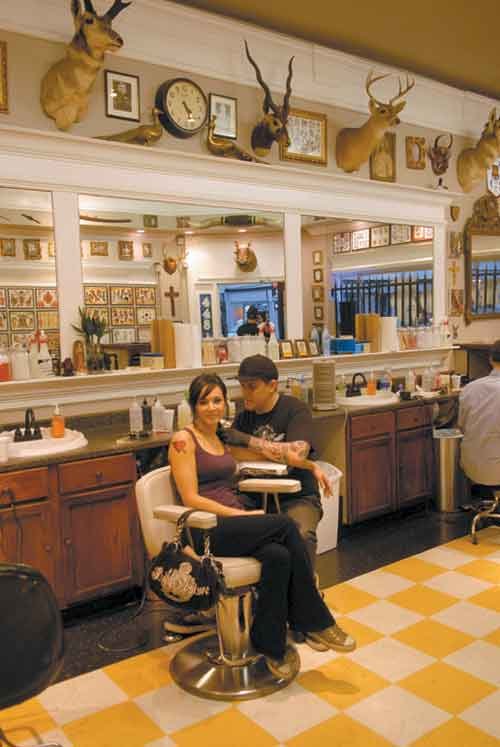K, so you considered the consequences, weighed the pros and
cons, and you’re still committed to the get-a-tattoo New Year’s
resolution. You’re ready to be inked. Or are you?
K, so you considered the consequences, weighed the pros and cons, and you’re still committed to the get-a-tattoo New Year’s resolution. You’re ready to be inked. Or are you?
Before needles perforate your epidermis, are you positive all the right questions have been asked, all the pertinent information has sunk in?
Sure, tattoos are acceptable today, but body art remains a polarizing form of self-expression. The Journal of the American Academy of Dermatology reports that one-quarter of U.S. adults sport at least one tattoo. In the same study, 17 percent of those with tattoos were considering having them removed.
If your profession involves working with the public, give serious thought to where you’re tattooed. If it can be seen while you’re fully clothed, it may be a problem.
“Wild Bill” Hill, owner of Wild Bill’s Tattoo in Roseville, says he abides by this rule: “I never wanted to be responsible for someone not being able to get a job because of a tattoo they can’t hide.”
Hill, who employs 10 full-time artists and accommodated around 5,000 clients last year, won’t tattoo hands, faces or necks. About 10 years ago, he says, he changed his longtime practice of not tattooing women on their arms. Times change.
Several law enforcement agencies, including the Sacramento County Sheriff’s Department in California, have ordered officers to cover up tattoos while on duty. Displaying tats has resulted in public complaints and fears that deputies with tattoos weren’t really deputies, but felons impersonating deputies.
Mostly, only the bad guys displayed tattoos in days gone by. Outlaw bikers, prison inmates and street gangs are only a portion of today’s tattooed population.
If you’re certain you want skin art, the following primer will help guide you through the experience.
TV AND TATTOOS
For the uninked, TV reality shows like “Miami Ink” and “LA Ink” drop the veil of mystery about what goes on inside a tattoo shop. Like all reality shows, it’s not all real, but it’s close enough. Watch and learn.
Ami James of “Miami Ink” and Kat Von D of “LA Ink” are two good reasons the tattoo has reached a higher level of acceptance. The popular shows air on TLC, a basic cable channel, along with the newest spinoff, “London Ink.” All focus on tattoo artists working in busy shops.
When Kat Von D left “Miami Ink” to open her own shop in “LA Ink,” the premiere episode drew 3 million viewers, the most for a TLC series-opener in four years. That episode also was TLC’s highest-rated premiere ever among people ages 18-34.
WHO YA GONNA CALL?
Ami and Kat are booked for months, so who will do the honors? Judge tattoo artists by reputation or by seeing work you really like. Ask about the artist.
Visit tattoo shops and go through the portfolios of each artist to find the style you seek. Check out shop Web sites for images, artist bios and prices. Ask artists questions and watch them work. You’ll want to feel comfortable with somebody who is going to leave a lasting impression on your skin.
BEST TIME OF YEAR
Tattoo artists are busiest in the spring, especially April and May. People like to be tattooed in spring so they can show new looks in summer.
Winter is a slower time for artists, and some will be more willing to negotiate prices.
HOW LONG DOES IT TAKE?
At an “in-and-out” shop, you can drop in without an appointment for a simple, small tattoo that can be applied in short order.
Shops that specialize in complex, detailed tattoos might want to discuss and plan the image with clients, sometimes over a couple of sessions before going under the needle.
Modern Body artist Alfredo Matta says the shop works with clients to design unique, personal tattoos.
“They tell us what they want and we design it,” he says. “They’re involved with the artist and the design. We’re mostly appointment only.”
Kevin Leary, an artist at Royal Peacock Tattoo, says he’s already spent 30 hours on a single tattoo.
“I figure about another 10 hours before it’s done,” he says.
A big, detailed tattoo, say over the entire back, can require sessions spread out over a year or more. Session payments are spread out, too, which brings us to …
HOW MUCH DOES IT COST?
Like getting an estimate from a home-remodeling contractor, the money you’ll pay for a tattoo varies. A little tattoo, say a red heart, may cost $50 to $80, but large, detailed tattoos often exceed $1,000 and are done over several sessions. An entire-back tattoo done by a top professional and in great detail may run $3,000.
“Tattoos aren’t cheap,” says Hill. “Good tattoos aren’t cheap, and cheap tattoos aren’t good.”
A top tattoo artist can charge and get $100 to $125 an hour, sometimes more. Check the shop’s Web site and sample some of the fee structures.
BIG OR SMALL?
Generally, tattoo artists prefer to “go big” for more detail and impact (and money). On the other hand, the American Society for Dermatological Surgery recommends smaller tattoos “with two or three colors” because they’re easier to remove and conceal.
NO DRINKIN’ AND INKIN’
Many tattoo shops have a “No Drunks” sign prominently displayed. People under the influence of alcohol and other mind-altering substances are prone to making poor decisions, including demanding a tattoo.
Wayne’s Tattoo Studio in San Bruno explains its policy like this on its Web site: “No drunks or druggies, and we prefer that people bathe regularly.”
IS THE TATTOO TREND FADING?
Nothing points to a decline, but if there’s one thing certain about pop culture, it’s always evolving, seeking out fresh ingredients for its next entree.
“It appears tattoos are still really popular,” says Jesse Kavadlo, an assistant professor at Maryville University in St. Louis who lectures and writes about pop culture. “What might be waning is the stigma attached to it, as more and more people in power are getting tattoos.”
REMOVING TATTOOS
Tattoos should be considered permanent, which is why the decision to be tattooed is so important. There are methods to fade, hide, sometimes obliterate tattoos, but they’re costly, painful and time-consuming. Tattoo removal by laser – the most common treatment – depends on size and color scheme. The laser beam breaks the pigment into small particles that eventually fade away.
Cosmeticsurgery.com says that making a small, single-color tattoo disappear might take just two sessions at $100 per session. Larger, multicolored tats could cost you $500 per treatment, and may involve additional costs, depending on where the tattoo is located and whether you’ll need anesthesia.
“Yellow is the most difficult color,” says Dr. Roy Geronemus, director of the Laser & Skin Surgery Center of New York and spokesman for the American Society for Dermatologic Surgery. “There’s no wavelength of light that will be absorbed by the color. Green is more resistant, too.”
Tattoos can also be removed with a scalpel and “sanded” off during a treatment called dermabrasion.
A new, so-called removable ink called Freedom-2 is being introduced, but many artists are reluctant to create tattoo art that may be considered temporary.
“A tattoo is a commitment you make,” says Matta of Modern Body. “Removing it is demeaning to the artist.”












